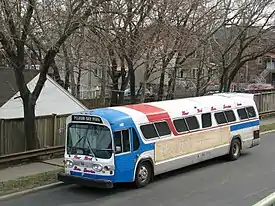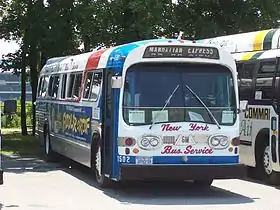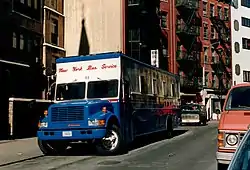New York Bus Service
New York Bus Service was a private bus company in New York City, United States. Originally a school bus company founded in the mid-1940s, it was best known for providing express bus service between Midtown Manhattan and eastern sections of the Bronx from 1970 until July 1, 2005, when the city (MTA) assumed the company's operations from longtime owner Edward Arrigoni.[1][2] Former NYBS routes currently operate under the MTA Bus Company brand of the Metropolitan Transportation Authority, out of the former NYBS facility in Eastchester, Bronx.[1]
 A former GM Fishbowl bus built in 1982. | |
| Founded | 1944 or 1945 |
|---|---|
| Defunct | 2005 |
| Headquarters | Tillotson Avenue near Conner Street Eastchester, Bronx, NY, 10475-1398 |
| Service area | Bronx, Manhattan, Queens |


History
The company began as the "station wagons-for-hire" business of Ferdinand E. Arrigoni.[3] It was officially founded in either 1944 or 1945 under the name Parochial Bus Service to provide school bus service.[4] It began operating racetrack services from the Bronx and Upper Manhattan in 1949, then operating as New York Bus Tours.[4] In 1964, contemporary owner Edward F. Arrigoni took over the company after the death of his father.[3][5] The company later operated service to the 1964 New York World's Fair (under the subsidiary Ferdinand Arrigoni, Inc.) and to New York Mets games at Shea Stadium beginning in 1966, both from the George Washington Bridge Bus Station in Washington Heights, Manhattan.[6][7][8] The Shea Stadium service would also operate from Fordham Plaza, Parkchester, and several other locations in the Bronx.[8] By 1968, the company began operating under the name New York Bus Service.[8]
With the institution of off-track betting legislation in 1970, the demand for transportation to the race track diminished. New York Bus Service needed to find another niche in the bus transportation sector. Under the leadership of owner Edward Arrigoni, New York Bus Service commenced Parkchester - Manhattan express bus service (now the BxM6) on August 24, 1970.[9] Six more lines were added including a Co-Op City to Wall Street express bus service, later to be done away with. These express bus routes would run frequently during AM and PM peak periods.[10]
New York Bus Service also previously operated two local bus routes in 1968 from Co-op City to the Wakefield–241st Street station via Baychester Av. (Bx71), and from Co-op City to the Eastchester–Dyre Avenue station (Bx70). Both of these routes were discontinued in 1972 due to low ridership.
New York Bus Service designed the standard New York City Department of Transportation Private Lines driver badges and discovered ways of reducing rollsign wear.
City takeover and current status
As part of a major takeover of the remaining private bus operators, on March 23, 2005 the city of New York announced it had agreed to take over NYBS operations. The city made an initial buyout payment of two million dollars for rights to the Bronx express bus lines NYBS operated. The MTA Bus Company (the successor to the private line operations) meanwhile agreed to pay Arrigoni and the other NYBS owners six million dollars annually for use of its depot and maintenance facilities for a period of twenty years, with an option to purchase afterwards.[11][12][13][14] On July 1, 2005, NYBS ceased operations and the former bus routes began operating under MTA Bus. The MTA has since renamed the garage to Eastchester Depot.[1][15][16] The large facility currently provides heavy maintenance services, along with a body shop for collision rebuilding and repairs for many MTA, and NYCT buses, stores "system reserve" buses, and handles much of the scrapping duties, including usable parts removal with components salvage and removal operations from all retired buses.[1][17]
Bus routes
Prior to the MTA Bus takeover, New York Bus Service operated the following express bus routes with starting dates:[2]
| Route (Name) |
Terminal A | Major streets of travel | Terminal B | Notes |
|---|---|---|---|---|
| Bronx-Manhattan Express | ||||
| BxM-6[9] (Parkchester Express) |
Midtown Manhattan East 23rd Street and Madison Avenue |
Manhattan: 5th Avenue (southbound), 3rd and Madison Avenues (northbound), 72nd Street (eastbound) Bronx: East 177th Street, Metropolitan Avenue |
Parkchester Metropolitan Oval |
Established; August 24, 1970 |
| BxM-7[18] (Co-Op City Express) |
Midtown Manhattan East 23rd Street and Madison Avenue |
Manhattan: 5th Avenue (southbound), 3rd and Madison Avenues (northbound), 72nd Street (eastbound) Bronx: Hutchinson River Parkway East, Co-Op City Boulevard |
Co-op City Dreiser Loop |
Established January 18, 1971 |
| BxM-7A[18](Pelham Bay Express) |
Midtown Manhattan East 23rd Street and Madison Avenue |
Manhattan: 5th Avenue (southbound), 3rd and Madison Avenues (northbound), 72nd Street (eastbound) Bronx: Westchester Avenue, Bruckner Boulevard |
Pelham Bay Pelham Bay Park subway station ( 6 <6> trains) |
|
| BxM-7B[18] (City Island Express) |
Midtown Manhattan East 23rd Street and Madison Avenue |
Manhattan: 5th Avenue (southbound), 3rd and Madison Avenues (northbound), 72nd Street (eastbound) Bronx: Westchester Avenue, Bruckner Boulevard |
City Island City Island Avenue and Rochelle Street[19] |
|
| BxM-9 (Throggs Neck Express) |
Midtown Manhattan East 23rd Street and Madison Avenue |
Manhattan: 5th Avenue (southbound), 3rd and Madison Avenues (northbound), 72nd Street (eastbound) Bronx: Randall Avenue, Harding Avenue, Throgs Neck Boulevard (outbound), Clarence Avenue (inbound) |
Throggs Neck Layton Avenue and Ellsworth Avenue |
Established; August 2, 1976 |
| BxM-10 (Morris Park Express) |
Midtown Manhattan East 23rd Street and Madison Avenue |
Manhattan: 5th Avenue (southbound), 3rd and Madison Avenues (northbound), 72nd Street (eastbound) Bronx: Morris Park Avenue, Eastchester Road |
or
|
|
| Bronx Local Buses (1968-1972) | ||||
| Bx70 | Co-op City | Eastchester Dyre Avenue subway station ( 5 train) |
Discontinued in 1972 due to low ridership. | |
| Bx71 | Co-op City | Baychester Avenue | Wakefield Wakefield-241st Street subway station ( 2 train) |
Discontinued in 1972 due to low ridership. |
References
- Silverman, Norman (July 26, 2010). "The Merger of 7 Private Bus Companies into MTA Bus" (PDF). apta.com. American Public Transportation Association, Metropolitan Transportation Authority. Archived from the original (PDF) on October 16, 2015. Retrieved October 16, 2015.
- Urbitran Associates, Inc (May 2004). "NYCDOT Bus Ridership Survey and Route Analysis Final Report: Chapter 3 Transit System Characteristics" (PDF). nyc.gov. New York City Department of Transportation. Retrieved October 16, 2015.
- Martin, Douglas (October 29, 1988). "About New York; Offering $10,000 To Help Uphold A Social Contract". The New York Times. Retrieved October 31, 2015.
- "Privately Operated Bus Service: History Of New York City's Private Bus Operators". nyc.gov. New York City Department of Transportation. Archived from the original on January 6, 2006. Retrieved January 19, 2007.
- "Deaths". The New York Times. February 15, 1964. Retrieved October 31, 2015.
- Bennett, Charles G. (January 24, 1964). "WIDE BUS SERVICE TO FAIR PLANNED". The New York Times. Retrieved October 31, 2015.
- "New York Bus Tours Offers Service to Shea Stadium" (PDF). The New York Times. May 29, 1966. Retrieved October 31, 2015.
- "Bronx Bus Service is Slated for Mets" (PDF). The New York Times. April 14, 1968. Retrieved October 31, 2015.
- "Transport News and Notes" (PDF). The New York Times. August 25, 1970. Retrieved October 31, 2015.
- Manhattan East Side Transit Alternatives Study (MESA): Environmental Impact Statement. January 1, 1999.
- Rutenberg, Jim; Ramirez, Anthony (March 23, 2005). "Metro Briefing New York: Bronx: City To Take Over Another Bus Line". The New York Times. Retrieved October 31, 2015.
- Lueck, Thomas J. (April 23, 2005). "City to Buy Private Bus Company for Service in Three Boroughs". The New York Times. Retrieved October 13, 2015.
- "The MTA Newsroom: MTA Bus Service Begins". Metropolitan Transportation Authority. January 2005. Archived from the original on January 21, 2005. Retrieved October 31, 2015.
- "Mayor Michael R. Bloomberg Announces Agreement with New York Bus Service, Inc". March 22, 2005. Retrieved June 27, 2016.
- "Eastchester Depot". Flickr - Photo Sharing!. Retrieved June 27, 2016.
- DiNapoli, Thomas P. (October 1, 2010). MTA Bus Company and New York City Transit: Selected Aspects of Vehicle Fuel Procurement and Use. DIANE Publishing. ISBN 9781437934205.
- Donohue, Pete (October 31, 2008). "The living-dead buses in the Bronx". Daily News (New York). Archived from the original on October 29, 2014. Retrieved October 16, 2015.
- "New York Bus Service sign East 45th Street Pelham Bay/City Island Express". facebook.com. Retrieved June 26, 2016.
- City Island Express Schedule (New York Bus Services; Archived from April 6, 2005.)
- Morris Park Express (New York Bus Service; Archived from April 3, 2005)
- MTA Regional Bus Operations. "BxM10 bus schedule" (PDF).
- Iona College Honors Edward Arrigonni as an Alumni
- National Bus Trader April 1985 Issue